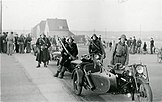
Back الغزو الألماني للدنمارك (1940) Arabic Německá invaze do Dánska Czech Invasionen af Danmark i 1940 Danish Γερμανική εισβολή στη Δανία (1940) Greek Invado de Danio Esperanto Invasión de Dinamarca Spanish Danimarkako inbasioa Basque تهاجم آلمان به دانمارک (۱۹۴۰) Persian Tanskan valtaus Finnish Invasion du Danemark French
| German invasion of Denmark | |||||||||
|---|---|---|---|---|---|---|---|---|---|
| Part of Operation Weserübung | |||||||||
| |||||||||
| |||||||||
| Belligerents | |||||||||
|
|
| ||||||||
| Commanders and leaders | |||||||||
|
|
| ||||||||
| Strength | |||||||||
|
Höheres Kommando XXXI:[2] 170th Infantry Division 198th Infantry Division 11th Schützen Brigade 527 aircraft (of the X. Fliegerkorps)[3] |
14,500 soldiers (Zealand, Jutland divisions, & Bornholm garrison)[4] 4 air force squadrons 2 coastal defence ships 6 torpedo boats 7 submarines 3 minelayers 9 minesweepers 4 inspection ships | ||||||||
| Casualties and losses | |||||||||
|
Uncertain (see Casualties) 2 captured 4 tanks damaged 12 armoured cars destroyed or damaged 1 aircraft damaged[5] 1 tugboat sunk[6] 1 battleship grounded |
16 killed[7] 20 wounded[7] 12 aircraft destroyed 14 aircraft damaged | ||||||||
The German invasion of Denmark (German: Operation Weserübung – Süd), was the German attack on Denmark on 9 April 1940, during the Second World War. The attack was a prelude to the invasion of Norway (German: Weserübung Nord, 9 April – 10 June 1940).
Denmark's strategic importance for Germany was limited. The invasion's primary purpose was to use Denmark as a staging ground for operations against Norway, and to secure supply lines to the forces about to be deployed there. An extensive network of radar systems was built in Denmark to detect British bombers bound for Germany.
The attack on Denmark was a breach of the non-aggression pact Denmark had signed with Germany less than a year earlier. The initial plan was to push Denmark to accept that German land, naval and air forces could use Danish bases, but Adolf Hitler subsequently demanded that both Norway and Denmark be invaded.
Denmark's military forces were inferior in numbers and equipment, and after a short battle were forced to surrender. After less than two hours of struggle, Danish Prime Minister Thorvald Stauning ended the opposition to the German attack, for fear that the Germans would bomb Copenhagen (København), as they had done with Warsaw during the invasion of Poland in September 1939. Due to communication difficulties, some Danish forces continued to fight, but after a further two hours, all opposition had stopped.
Lasting approximately six hours, the German ground campaign against Denmark was one of the shortest military operations of the Second World War.[8]
- ^ Dildy 2007, p. 15.
- ^ Dildy 2007, pp. 18, 28.
- ^ Hooton 2007, p. 29.
- ^ Dildy 2007, p. 22.
- ^ Hooton 2007, p. 31.
- ^ Lindeberg 1990, p. 98.
- ^ a b Zabecki 2014, p. 323.
- ^ Dildy 2007, p. 34.





